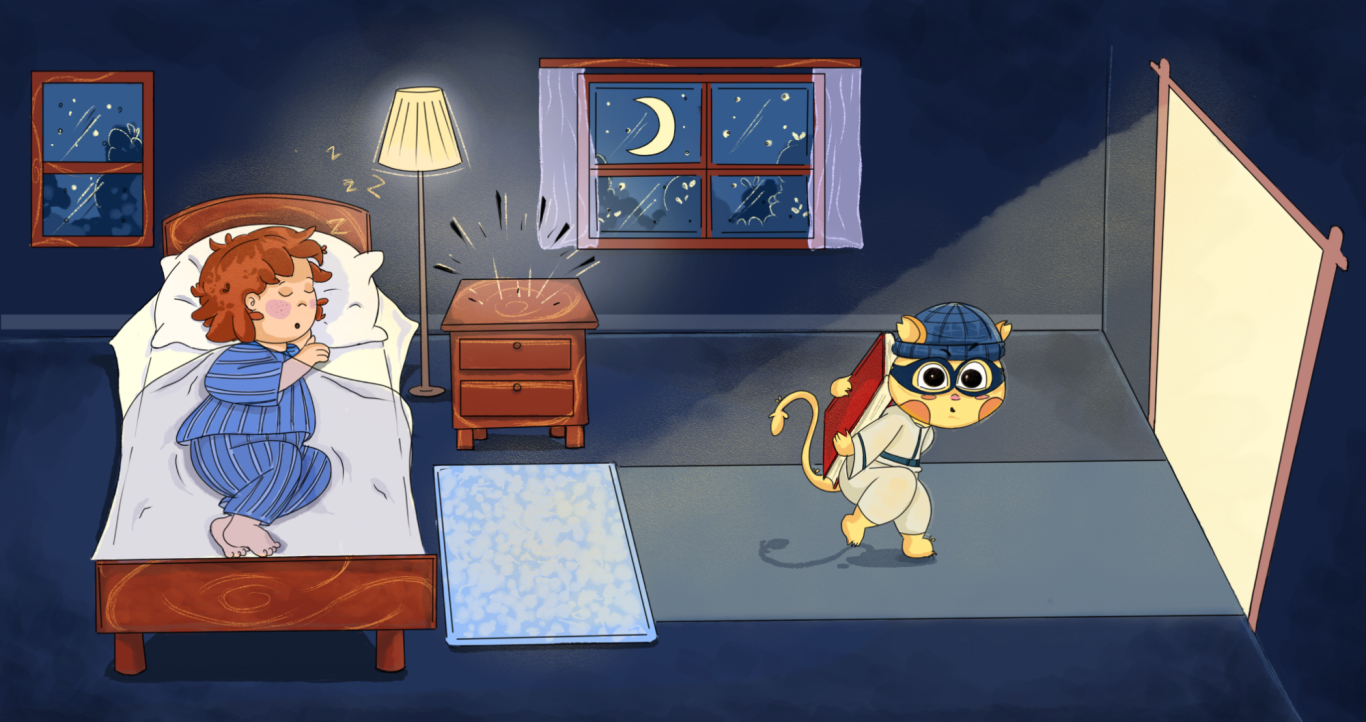
The story of Tippy Tarsy
On the image above, you see a scene that could take place in any bedroom in the world. It is the middle of the night, and all you can hear is the sound of someone breathing as they sleep. Suddenly, there is a soft creak as the door of the room opens and a small figure creeps in. It darts straight to the bedside table, grabs the book lying there and tiptoes out again with its prey. This little scene takes place countless times every night – and nobody knows anything about it.
The very beginning
In 2018, a group of researchers at a renowned university was tasked with investigating the behaviour of tarsiers. Tarsiers are little animals with huge eyes that are increasingly found in countries such as the Philippines, Malaysia and Indonesia.
These animals were already known to be very shy and to climb through the trees of the jungle. But scientists could not explain why these creatures had such large eyes. In autumn 2018, the researchers set out for the Philippines, led by a man we’ll call Henry. Their destination was an ancient jungle that was home to many tarsiers with an unusually trusting nature. The researchers spent the first weeks of their study measuring the animals, recording their height and weight as well as the length of their arms, legs and fingers. They remained completely in the dark, however, as to the reason behind the tarsiers’ extremely large eyes – especially as they seemed to spend most of their time sleeping.
Strange happenings
For the duration of their field trip, all of the researchers were housed in a large building near to the ancient jungle, where the team had a whole floor to themselves. One morning, Henry noticed that the book he had been reading the night before, just before falling asleep, had disappeared from his bedside table. Later on, to his surprise, he found it in the sink of his bathroom. Henry assumed that one of his colleagues had played a trick on him and thought little more of the incident.
When he woke up the next day, however, his book had once again vanished from his bedside table. He later found it next to a pile of socks on his dresser. By this point, Henry no longer found the prank funny and confronted his colleagues. But when he spoke to them, it became clear that he was not the only victim. His colleagues’ books had also been disappearing from their bedside tables, only to turn up elsewhere in their rooms the next morning. Neither Henry nor his colleagues could explain what was going on.
On the culprit’s trail
The whole story took a surprising turn when Henry went into the jungle one morning and found the book he had been reading the previous evening before going to bed: it was lying on the ground next to a sleeping tarsier. At that moment, a bizarre thought occurred to him – one that contradicted everything he had learned during his studies. He decided to install some cameras to film the nocturnal activities of the animals. He also set one up in his room, pointing the lens right at his bedside table. When he went to bed that night, he did everything just as he had done the night before: he read a few pages of his book, placed it on his bedside table and fell asleep.
The moment of truth
The next day, when Henry woke up, his book had mysteriously found its way from his bedside table to his desk. He leaped out of bed, connected the camera to his computer and played back the recordings. The clock at the bottom of the display showed the time of one o’clock in the morning. A shadow appeared at the door: it was not particularly large, and crept over to Henry’s bed. A pair of skinny little arms could be seen reaching out for the book and carefully lifting it from the bedside table. Then the creature tiptoed out of the room with its prey.

The first photographic evidence
The nocturnal thief had, however, made one error: just as he left the room, he turned to the camera and showed his face. And, as Henry had guessed, the culprit was an animal. More precisely, it was a tarsier. Henry also checked the cameras that he had positioned in the jungle. The recordings showed the tarsier climbing down from its tree, slinking towards the researchers’ accommodation and returning later on with a book in its hands. The animal then spent the next four hours sitting on the ground and bent over the book – almost as if he were reading it…
The theory of evolution unravels
It’s hard to describe what was going on in the minds of the researchers. They were all adults who had studied at renowned universities and dedicated their lives to science. During their studies, two basic truths had been instilled into them: everything has a logical explanation, and never question Charles Darwin, the famous scientist who studied the evolution of man and animals. If all of Darwin’s findings could be summarised in a sentence, it would probably be the following: the biggest difference between humans and animals is that humans can read while animals cannot. But now the researchers were in possession of video recordings that showed little animals with large eyes reading books. This went against the teachings of Charles Darwin and was also highly illogical. Put simply, the researchers had a problem.
They agreed not to tell a soul about their discovery, fearing for their scientific careers. Fortunately, however, they decided to continue their research. Some of them even founded their own “bio-literary” research departments to investigate the effects of literature on animal development.
The results of the bio-literary studies
Once Henry and his team had established that tarsiers could read, they wanted to find out whether the animals had a preference for particular types of books. Over a period of two weeks, they laid out a wide variety of books in the jungle. The results were something of a surprise: the tarsiers liked children’s books best. Preferably ones that were set in fantasy worlds and had a very exciting plot. The little creatures also proved to be very fussy when it came to style. If a book was not written in a clear and concise language that was free from long, convoluted sentences and unnecessary adjectives and adverbs, then they quickly lost interest. The little animals would only read all the way to the end of the top 1% of books – in other words, the books that fulfilled these criteria.

The tarsier’s sixth sense
Animals have always had abilities that we humans lack. Certain pigs can snuffle out truffles growing deep beneath the surface of the ground, for example, which are then traded like gold. Some dogs have the rare ability of being able to sniff out cash. This cash is not found underground, like the truffles, but rather in the luggage of smugglers who want to trick customs officials. Tarsiers possess a sixth sense that allows them to spot bestsellers: only the books that they read from cover to cover make it to the top of the bestseller lists.

The founding of Tippy Tarsy
This astounding research is what led us to found our publishing house. Our team is small, consisting of just a few people and many tarsiers who are hungry for books. Our concept is simple: all the manuscripts we receive are tested out on our tarsiers. If our furry little colleagues read the text all the way to the end, we know that we have a future bestseller on our hands.
In honour of the groundbreaking findings of Henry and his team of researchers, we named our publishing house after the little tarsier he filmed tiptoeing out of his room. Hence the name: “Tippy Tarsy”.
A strange phenomenon
To conclude, we would like to share a last secret with you. During their research, Henry’s team noticed that the tarsiers never returned the “borrowed” books to the same spot they had pinched them from. Instead of placing the books back on the researchers’ bedside tables, the animals left them on shelves and dressers, or in sinks and dustbins.

One tarsier was even caught on camera depositing his book onto the cistern of a toilet early in the morning. The researchers suspect that the reason for this is the tarsiers’ highly developed imagination, which is similar to that of children. This imagination allows them to dream themselves into the stories they read – so much so that they forget everything around them, including the original location of the books they swipe.
If you want to investigate whether there is a tarsier who loves to read living in your neighbourhood, we recommend that you buy one of our books and leave it on your bedside table at night. The next day, check whether the book has been placed elsewhere in your bedroom. If so, it’s very likely that a tarsier has been at work.
Take a photo of where you find your book and share it with us on social media. We can’t wait to hear where the tarsiers leave your books!
©Copyright. All rights reserved.
